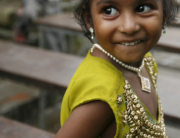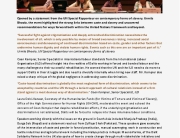Pakistan has ratified a number of international covenants and conventions which proscribe slavery, forced labour, and debt-bondage. The Constitution of Pakistan forbids slavery and forced labour, and the Bonded Labour System (Abolition) Act of 1992 along with the Bonded Labour System (Abolition) Rules of 1995 completely outlaw bonded labour. They also cancel all existing bonded debts and forbid lawsuits for the recovery of such debts.
Worst forms of modern-day slavery
Yet bonded labour in Pakistan is widespread. The ILO assesses the problem of debt bondage in Pakistan as one of the worst in the world(1). Bonded labour is particularly common in the areas of agriculture, brick-making, carpet-weaving, mining, tanning, cotton seed production, handicraft production, production of glass bangles, and domestic work, reports anotherILO working paper (2).
There is no exact calculation of the number of bonded labourers. Research by the Pakistan Institute of Labour Education and Research (PILER) in 2000 estimated that the total number of sharecroppers (haris) in debt bondage across the whole of Pakistan was over 1.8 million people. Furthermore,surveys showed that more than 6.7 million people are involved in the practice of begar, which refers to a traditional system of family labour which is unpaid, compulsory, and amounts to debt bondage(3). Hence the calculated number of people kept in bondage based on the PILER study amounts to more than 8.6 million. The Human Rights Commission of Pakistan in 1994estimated that approximately 20 million are kept in forced labour(4).
The majority of the bonded labour community belongs to marginalized and excluded groups such as the scheduled caste Hindus, Christians and Muslim Sheikhs.
Agriculture and brick kilns
The two most prominent sectors characterized by a significant use of bonded labour are agriculture and brick kilns(5). Research carried out by PILER in Pakistan in 2000 indicates that up to 1 million brick kiln workers in Pakistan are bonded(6). A 2004 survey of brick kilns in the Punjab district in Pakistan by the Federal Bureau of Statistics found that nearly 90 per cent of brick kiln workers were bonded. Also, surveys suggest that agriculture and brick kiln work are of the worst and harshest kinds due to the physical strain, social discrimination and hazardous working conditions(7). Human Rights Watchinterviews with brick kiln forced labourers reveal consistent cruel, inhumane and degrading treatment, including physical punishment, detainment and denial of the right to organise(8).
Dalit Hindu minorities the main target
Bondage both in agriculture and in brick-kilns includes severe forms of oppression. This ranges from physical restraints upon the movement of the workers and their families to beatings and sexual abuse of female workers. Dalits and other low caste Hindus bear the brunt of these abuses because of their minority status. The multiple disempowerment of being poor, low caste or Dalit as well as non-Muslim are the main contributing factors to the oppressive conditions of bonded labour in Pakistan claims a PILER report(9).
Violations against sharecroppers are particularly acute in lower Sindh and in southern Punjab bordering India. The latter is also considered to be the main geographical area of severe oppression against brick-kiln workers and their families. PILER estimates that these sharecroppers will be subjected to increased excesses of bondage because landlords in recent times have been facing adverse economic pressures(10).
The sharecroppers often live in camps, where they are also subjected to incarceration, and some report of being shackled and raped. As with the general scenario, children are even more vulnerable than their adult counterparts. Children in brick kilns report of being beaten with sticks and whipped to the point of injury. They do not receive compensation for their work, and are also sometimes kept as insurance to prevent the escape of adult family members, reports Human Rights Watch(11).
Ineffective Legislation
The Bonded Labour (System) Abolition Act 1992, created to eradicate this practice was initially considered a major intervention on the part of the State. However, 15 years down the road, bonded labour is far from abolished.
A recent report from Anti-Slavery International prepared in association with PILER in July 2008 stated that the Government had failed to implement the National Policy and Plan of Action (2001) for the abolition of Bonded Labour and Rehabilitation of freed bonded labourers (an extension of the 1992 Bonded Labour System Abolition Act)(12).
In 2002, a Bonded Labour Fund was established as part of the law for the welfare of the children of released bonded labourers, the majority of whom are scheduled castes. Six years later a substantial portion of the funds remain unused and held by government and the released bonded labourers continue to live in subhuman conditions in temporary camps on the outskirts of Hyderabad according to a joint NGO alternative report for CERD (13).
UN Treaty body recommendations
In its review of Pakistan during its 74th session in February 2009, the UN Committee on the Elimination of Racial Discrimination (CERD) addressed the persistence of bonded labour in the country. Some of its recommendations on this topic were:
1. The government should ensure that ethnic and religious minorities are adequately represented in all government services, especially the armed forces, superior civil services and judiciary.
2. The Bonded Labour System (Abolition) Act. 1992 should be applied and amended further to penalize land lords maintaining bonded labour.
3. The jurisdiction of labour officer should be extended to agriculture sector and their number should be increased for effective monitoring. Moreover the Vigilance committees given in the law should be formed and a transparent functioning should be ensured.
4. The Government should restore the six percent quota for religious minorities and scheduled castes in government services. A monitoring desk should be established to oversee the implementation of quota.



